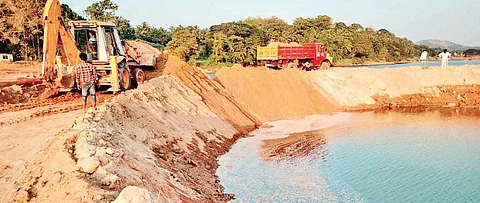

KOCHI: While work on the Indian Oil Corporation Ltd’s LPG Import Terminal began on Monday after two years, another key project, Gas Authority of India Ltd’s (Gail)’s `3,263-crore Kochi-Koottanad-Bengaluru-Mangaluru natural gas pipeline project (KKBMPL), which faced protests in northern parts of the state, is quietly progressing at a fast clip.
The first stretch of 96km from Kochi to Koottanad was commissioned in June this year.
Koottanad is the point from where the pipeline bifurcates to Mangaluru (via Malappuram, Kozhikode, Kannur and Kasaragod) and to Bengaluru (via Palakkad, Coimbatore, Erode, Salem Dharmapuri and Krishnagiri). Tony Mathew, general manager (construction), GAIL, said of the total length of 444km from Kochi to Mangaluru, pipe-laying on the 441.5km stretch has been completed and work on the remaining 2.5km is in progress across five rivers — Netravati (Mangaluru), Chandragiri (Kasaragod), Kuttiyadi, Chaliyar and Iruvanjippuzha in Kozhikode district.
“We hope to commission the pipeline up to Kozhikode by February 2020 and the entire project will be commissioned by March 2020” he told TNIE. The KKBMPL is an ambitious project initiated in 2007 by GAIL to connect the southern states of Kerala, Tamil Nadu and Karnataka to the national gas network. The deadline for the project was December 2018, but the flood last year and frequent protests in northern districts in the state held up the work.
Mathew said there are 28 stations (including 23 sectionalising valve (SV) stations and five intermittent pigging (IP) stations and receiving terminal at Mangaluru) on the 444km stretch.The SVs are installed at regular intervals (around 25km to 40km) to isolate pipeline section during emergencies like leakage as per statutory requirements.
The SVs and IP stations are also the parts used for real-time monitoring of the gas supply.
The work in a majority of these stations have been completed and it is in the advanced stage of completion in the remaining stations, he said. “The commissioning of the project can facilitate piped natural gas to housholds and industries and compressed natural gas to automobiles in seven districts (in Kerala) and the Union Territory of Mahe,” Mathew said.
Petronet LNG Ltd’s liquefied natural gas (LNG) import terminal in Kochi, which has been operating at only 10 per cent of its five million-tonne-a-year capacity, will also see an improvement in its capacity once the GAIL pipeline is fully commissioned next year.
“(The work on) the 89km Koottanad-Walayar stretch is in progress and 75km welding is completed out of which 42km is lowered in soil. There are six stations including five SV stations and nine IP stations at Walayar) on this stretch,” said the GAIL official. “The commissioning of this stretch is expected by June 2020 which can facilitate gas supply to industries in Kanjikode and Coimbatore in addition to City Gas distribution at these places,” he added.
Meanwhile, 48km of the pipeline is being laid from Bengaluru to Hosur (reverse direction of Kochi-Bengaluru) to provide gas supply to industries in Hosur as Bengaluru is already connected with the National Gas Grid.
Mathew said the work in Tamil Nadu has not been started yet and discussion is in progress for final clearance from the Government of Tamil Nadu.